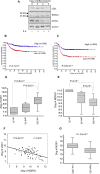LSD1 mediates MYCN control of epithelial-mesenchymal transition through silencing of metastatic suppressor NDRG1 gene
- PMID: 27894074
- PMCID: PMC5354800
- DOI: 10.18632/oncotarget.12924
LSD1 mediates MYCN control of epithelial-mesenchymal transition through silencing of metastatic suppressor NDRG1 gene
Abstract
Neuroblastoma (NB) with MYCN amplification is a highly aggressive and metastatic tumor in children. The high recurrence rate and resistance of NB cells to drugs urgently demands a better therapy for this disease. We have recently found that MYCN interacts with the lysine-specific demethylase 1 (LSD1), a histone modifier that participates in key aspects of gene transcription. In cancer cells, LSD1 contributes to the genetic reprogramming that underlies to Epithelial-Mesenchymal Transition (EMT) and tumor metastasis. Here, we show that LSD1 affects motility and invasiveness of NB cells by modulating the transcription of the metastasis suppressor NDRG1 (N-Myc Downstream-Regulated Gene 1). At mechanistic level, we found that LSD1 co-localizes with MYCN at the promoter region of the NDRG1 gene and inhibits its expression. Pharmacological inhibition of LSD1 relieves repression of NDRG1 by MYCN and affects motility and invasiveness of NB cells. These effects were reversed by overexpressing NDRG1. In NB tissues, high levels of LSD1 correlate with low levels of NDRG1 and reduced patients survival. Collectively, our findings elucidate a mechanism of how MYCN/LSD1 control motility and invasiveness of NB cells through transcription regulation of NDRG1 expression and suggest that pharmacological targeting of LSD1 represents a valuable approach for NB therapy.
Keywords: EMT; LSD1; MYCN; NDRG1; neuroblastoma.
Conflict of interest statement
The authors declare no conflict of interest.
Figures







References
-
- Irwin MS, Park JR. Neuroblastoma: paradigm for precision medicine. Pediatric Clinics of North America. 2015(62):225–256. - PubMed
-
- Maris JM, Hogarty MD, Bagatell R, Neuroblastoma Cohn SL. Lancet. 2007(369):2106–2120. - PubMed
-
- Schwab M. MYCN in neuronal tumours. Cancer letters. 2004(204):179–187. - PubMed
MeSH terms
Substances
LinkOut - more resources
Full Text Sources
Other Literature Sources
Medical
Molecular Biology Databases

